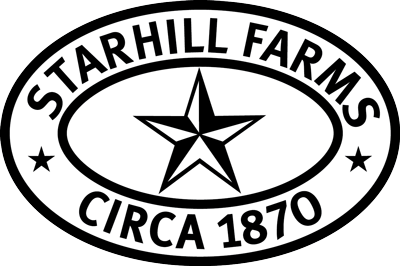Loofahs from our Garden
The loofah plant is a versatile, easy-to-maintain, space-saving crop in StarHill Farm’s garden.
Did you know, the loofah (luffa) plant is classified as both a fruit and a vegetable? Botanically, it is a fruit, because the seeds grow on the inside, although in the United States it is legally classified as a vegetable. Loofahs require a long growing period, with plenty of space and a sturdy trellis to grow on. Long warm summers is what a loofah likes best.
It certainly likes growing in StarHill Farm’s garden!
A relative of the cucumber, the loofah plant produces large gourds that leave a durable network of fibers after treating and drying. Once dry, the skin comes off with very little effort. Just fill a storage tub with water, then salt each gourd liberally before placing it in the bath. Some people add a bit of bleach or hydrogen peroxide to the tub to whiten the loofah. Dry the loofa thoroughly before use. The end-result is a mildly abrasive scrubber that can be used in a variety of ways.
When harvested, the loofah gourds can be used for many household products:
Use your loofah sponge to clean tough food on pots and pans:
The natural fibers will not scratch your pots and pans. You can clean the top of your stove, your cabinet doors, and tough spots on the floor, or anything else in the kitchen with your luffa without fear of damaging your surfaces. The thinner gourds are great for making pot/kitchen scrubbers.
How to prepare loofah as a sponge:
While they are still wet from the salt bath, cut them into two-inch wide sections with scissors or a serrated knife.
Allow the slices to dry.
To prepare a pot scrubber:
While they are still wet from the salt bath, cut them into two-inch wide sections with scissors or a serrated knife.
Place it in a Ziploc with enough baking soda and dish soap to cover it.
You could also add a few drops of orange essential oil, which is a terrific grease cutter. Rinse the loofah completely after use then return it to the baggie for storage after drying completely.
Use the Loofah as a Soap Saver or Bath Mittens:
Another great kitchen use for your loofah is for your soap dish:
You can slice a round of luffa and place it in your soap dish so your soap will sit up out of any collected water. It’s great to help make your soap last longer.
Use the thickest gourds to make bath mittens:
Cut them into slices four inches wide, then cut out the centers.
Set the centers aside, remaining seeds and all, for kindling.
The loofah ring that is left can be slipped over your hand and used as a washcloth.
Or, run a shoelace through the middle of the bath loofah and hang it in the shower loofah so it can dry out between uses.
Note:
Washing once or twice a week using your loofah as a sponge will give your skin a good exfoliating that will improve the look of our skin and improve circulation.
Once you’ve created your new bath mitten/body sponge, the first one or two uses may be a bit rough for sensitive skin, but the loofah softens up considerably after that. If you rinse it well and hang it to dry between uses, it will last several months.
Once you’ve taken a luxurious bath with your loofah body scrub, continue your self-care by using the loofah:
To clean your cuticles and under your nails.
You can also make a back scratcher with a loofah: Each loofah has tunneled holes from one end to the other. Put a flat stick (like a yard stick) through one of the holes and attach it with some adhesive. You could use glue or even just tie it. Then you could use the luffa to scratch your back or even wash your back in the tub.
Loofah scraps can be used for tough cleaning solutions in the garage.
If you have squares at least one-by-one inch they can be dipped in gasoline to clean greasy car parts, tools and spills.
Loofahs are great for cleaning those stuck on bugs that get stuck to the grill and front bumper of your car. Just soap up your grill or car, and scrub!
Super muddy shoes? Use loofahs to scrub the mud out of the treads.
Gourds that did not form properly can be saved as starter logs. Store them on the woodpile or another safe place. Before use, squeeze the gourd to create cracks in the skin. Spray hairspray into the fibers. You can also rub old lipstick onto the gourd to accelerate the fire, or start it without accelerant. You can also use the inside of the loofah, that you cut out while making bath mittens, for kindling.
As you can see, Loofahs can be used for many productive uses. It’s important to remember that over time, some of these uses can also harbor harmful bacteria in the loofah’s many tiny holes. Like all plant matter, loofahs are also susceptible to decay if kept constantly wet, so let your loofah air dry between uses. Washing it in a mild bleach solution could extend its useful life, but you should replace your loofah frequently. A clean loofah has a mild straw-like smell; any off-putting odors signify a loofah that needs to be replaced.
Enjoy this natural, eco-friendly product in your home. Let us know if you find other uses for your loofah!







